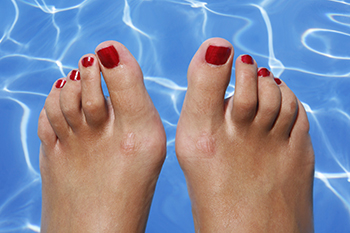1648 US Highway 130
North Brunswick, NJ 08902

Feet help propel the body forward when swimming. Range of foot motion, flexible ankles, and pointed toes are important for flutter kicks in freestyle swimming. However, muscle cramps can occur while swimming, which can be painful. In fact, the most frequent injury in this activity is from cramping. This can happen from overworking the muscles and from overtraining with weights. Cramping can also occur from dehydration in muscles. Inflammation and tendonitis from repetitive foot and ankle movements and pointing and flexing toes excessively while swimming can also occur. Poor swimming technique can contribute to such pain. One should drink plenty of water and use drinks fortified with electrolytes as well as relax the muscles for two or three days after training. A warm-up session before swimming can help to avoid cramping and pain on the tops of the feet, as well as improve muscle and joint flexibility. Likewise, stretching the ankles and toes can help prepare for more comfortable swimming. If you are a swimmer and experience foot pain, consult with a podiatrist who can offer you more advice and treatment options.
Ankle and foot injuries are common among athletes and in many sports. They can be caused by several problems and may be potentially serious. If you are feeling pain or think you were injured in a sporting event or when exercising, consult with Dr. Robert Fink from Brunswick Foot & Ankle Group. Our doctor will assess your condition and provide you with quality foot and ankle treatment.
Common Injuries
The most common injuries that occur in sporting activities include:
Symptoms
Symptoms vary depending upon the injury and in some cases, there may be no symptoms at all. However, in most cases, some form of symptom is experienced. Pain, aching, burning, bruising, tenderness, tightness or stiffness, sensation loss, difficulty moving, and swelling are the most common symptoms.
Treatment
Just as symptoms vary depending upon the injury, so do treatment options. A common treatment method is known as the RICE method. This method involves rest, applying ice, compression and elevating the afflicted foot or ankle. If the injury appears to be more serious, surgery might be required, such as arthroscopic or reconstructive surgery. Lastly, rehabilitation or therapy might be needed to gain full functionality in the afflicted area. Any discomfort experienced by an athlete must be evaluated by a licensed, reputable medical professional.
If you have any questions, please feel free to contact our office located in North Brunswick, NJ . We offer the newest diagnostic and treatment technologies for all your foot care needs.